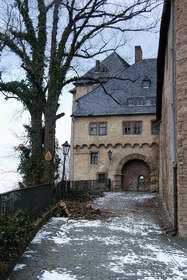County of Blankenburg
|
Territory in the Holy Roman Empire |
|
|---|---|
| County of Blankenburg | |
| coat of arms | |

|
|
| map | |

|
|
| County of Blankenburg (light blue) and surrounding territories around 1400
|
|
| Arose from | 1123: Harzgau |
| Form of rule |
County 1707: Blankenburg Principality |
| Ruler / government | Count , Prince |
| Today's region / s |
DE-ST
|
| Reichskreis | Lower Saxony |
| Capitals / residences | Blankenburg , Regenstein |
| Dynasties | House Blankenburg 1599: Blankenburg an Wolfenbüttel 1670: Regenstein an Brandenburg-Prussia |
| Language / n |
German
|
| Incorporated into | 1807: Kingdom of Westphalia 1815: Braunschweig or Prussia
|
The county of Blankenburg was a secular territory of the Holy Roman Empire in the area of today's federal states of Lower Saxony and Saxony-Anhalt . In the 13th century, a part of it was separated from him as County Regenstein by dividing the estate . In 1707, the county of Blankenburg was elevated to a principality, but the Prince of Blankenburg only received a viril vote in the Imperial Council of Princes in 1802 or 1803, shortly before the end of the old empire .
history
The castle Blankenburg was in 1123 as the property of the Duke of Saxony testified. Since 1128 a ministraler of the Guelph Poppo I von Blankenburg is attested as a count over the eastern Harzgau . He was related to the Counts of Northeim and related by marriage to Emperor Lothar von Supplinburg (1125–1137). Regenstein Castle , four kilometers north of Blankenburg, was first mentioned in 1167 . After Henry the Lion fell , the counts became vassals of the Halberstadt bishopric . As a result, the feudal rule between the Halberstadt Monastery and the Guelphs was unclear . In 1202/1203 and 1344 the castle and town of Blankenburg and Regenstein Castle were Guelph fiefdoms. In 1311, however, the area was considered a fiefdom of Halberstadt. In 1195/1203 the counts laid the town of Blankenburg at the foot of the castle. In the 13th and 14th centuries, the area was temporarily divided between the three lines of Blankenburg, Regenstein and Heimburg. In the middle of the 14th century there was reunification in the Heimburg line. However, the counts did not succeed in breaking free from Halberstadt's feudal dependence.
Therefore, after the death of Johann Ernst, the last Count of Blankenburg, his property fell as an apertes (= opened) fief in 1599 to Heinrich Julius von Braunschweig-Wolfenbüttel , who was also the postulated bishop administrator of the Halberstadt Monastery . He immediately gave the feudal estates, insofar as they were semi-urban fiefs, to his son Friedrich Ulrich, who then passed them on to his brother, Duke Christian , the “great Halberstadt”. A few years after the start of the Thirty Years' War (1624), the county of Blankenburg - without the Regenstein - came as an imperial pledge to Max von Waldstein, who in 1629 gave it to the imperial general Johann II, Count of Merode . After the fortunes of war had turned, Friedrich Ulrich took possession of the county again in 1631 (in return for a severance payment to Merode) and bequeathed it in 1634.
As administrator of the diocese, Christian Wilhelm von Brandenburg gave the fiefdom of Regenstein Castle to the Counts of Tettenbach in 1626. In 1642 Count Tettenbach was enfeoffed with the rest of the County of Blankenburg, namely the Brunswick shares. After the execution of Tettenbach (1671), the Welfs were only able to take these parts as repatriated , while the Regenstein part came to the House of Brandenburg as Prince of Halberstadt. The main part of the area, the owner of which was temporarily a member of the Westphalian Reichsgrafenkollegium , became the junior line of Braunschweig-Wolfenbüttel in 1690 . In 1707 the county of Blankenburg was raised to the status of an imperial principality. From 1731 the principality was permanently connected with Braunschweig-Wolfenbüttel in personal union, but remained an independent imperial estate until 1805.
In the 19th and 20th centuries, the area belonged to the Duchy of Braunschweig . The district of Blankenburg came almost completely to the state of Saxony-Anhalt after 1945 .
territory
The county of Blankenburg was in what is now Saxony-Anhalt . Neighboring gentlemen were:
- in the north the county of Wernigerode and the Halberstadt monastery ,
- in the southeast the Anhalt principalities ,
- in the south the county of Hohnstein ,
- Walkenried Abbey to the west .
Until 1945 it formed a separate administrative district of the state of Braunschweig and came mainly to the state of Saxony-Anhalt through the demarcation between the British and Soviet zones.
people
- Poppo I. von Blankenburg (* around 1095, † 1161 or 1164), Count of Blankenburg
- Reinhard von Blankenburg († 1123), from 1107 to 1123 Bishop of Halberstadt
- Hermann von Blankenburg , Bishop of Halberstadt (1296–1303)
- Burchard II of Blankenburg († 1305), Archbishop of Magdeburg
- Albrecht II of Regenstein (around 1293 - 1349), Count of Regenstein
- Ulrich X. von Regenstein-Blankenburg (* 1499; † 1551), Count of Blankenburg and Regenstein
- Elisabeth von Regenstein-Blankenburg , (* 1542; † 1584), Abbess of Quedlinburg
- Ludwig Rudolf von Braunschweig-Blankenburg , (* 1671; † 1735), Prince of Blankenburg, later Duke of Braunschweig-Wolfenbüttel

